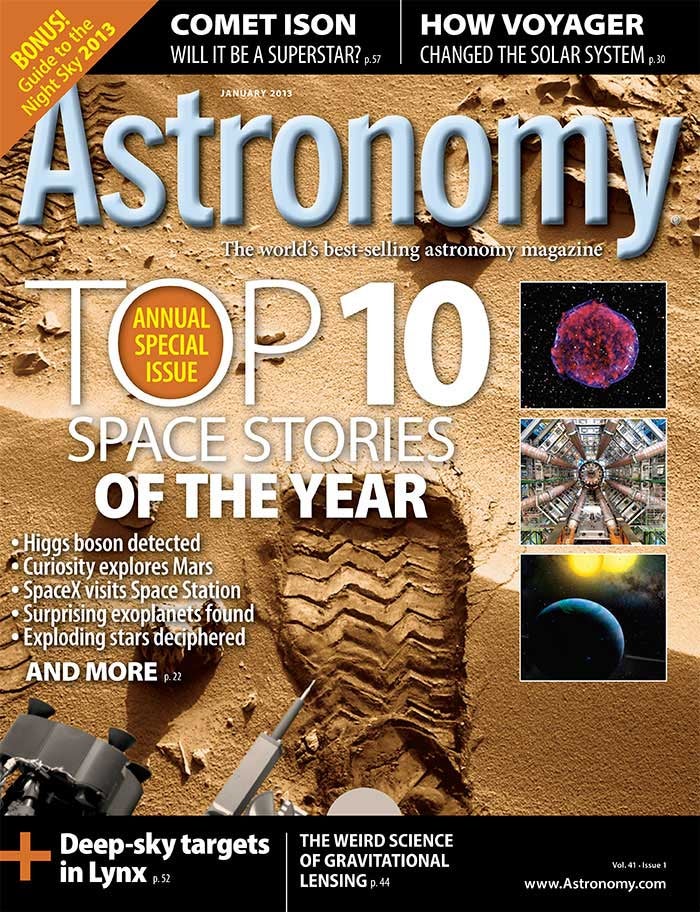
Waukesha, Wis. — In 2012, scientists spied the base of a black hole’s jet and detected a particle they’ve been seeking for 40 years. Also in the past year, planetary scientists landed the most-complicated rover yet on the Red Planet, uncovered secrets of the asteroid Vesta, and discovered planets in unexpected extrasolar environments. Manned space flight even saw a historic mission occur. It was a great year for space science discoveries — but what was the biggest story of the year?
Astronomy’s editors ranked the most important stories of the past 12 months, and Associate Editor Liz Kruesi highlights those discoveries in “Top 10 space stories of 2012.”
Read the countdown in the January 2013 issue of Astronomy magazine, on newsstands December 4.
“Will Comet ISON be a superstar?”
Get ready for what might be the brightest comet anyone alive has ever seen. Astronomers discovered Comet C/2012 S1 (ISON) in September, and with additional observations they’ve since refined its orbit. Senior Editor Michael E. Bakich writes about the comet’s discovery and provides an overview of the object’s predicted appearance — including its nearest approach in late November 2013 — and a large finder chart showcasing the comet’s 2013 trajectory in “Will Comet ISON be a superstar?”
“Voyager’s ‘new’ solar system”
Relive the biggest discoveries from one of the greatest planetary-science missions in “Voyager’s ‘new’ solar system.” The twin Voyager spacecraft, which both launched in 1977, embarked on a grand tour of the solar system’s giant planets — and their journeys aren’t over yet. Senior Editor Michael E. Bakich explores 10 of the most important Voyager findings, and describes how both probes are still returning valuable information about the Sun’s influence and should continue to do so for another decade.
“How gravity’s grand illusion reveals the universe”
An object’s intense gravity can bend, magnify, and amplify the light from a background object. Astronomers put this effect, called gravitational lensing, to use searching for distant galaxies, exoplanets, and unseen matter. “Over the past century, gravitational lensing has gone from an obscure theory to an indispensable tool for unraveling some of the universe’s deepest secrets,” writes Ray Villard in “How gravity’s grand illusion reveals the universe.”
January night-sky events visible without optical aid
- January 3 — The Quadrantid meteor shower peaks in the early morning hours.
- January 10 — The Moon passes 3° north of Venus.
- January 15 — Saturn stands more than 30° high in the southern sky roughly an hour before dawn.
- January 21 — The Moon passes 0.5° south of Jupiter.
Also in the January 2012 Astronomy
- “Astronomy’s 2013 Guide to the Night Sky” — This handy four-page insert will keep you looking up all year.
- “What’s lurking in Lynx” — Whether you use a big or small scope, this oft-neglected constellation will dazzle you with its celestial targets.
- “Astronomy tests the Canon 60Da” — Higher resolution, heightened red sensitivity, and other features make this DSLR the new standard for astroimaging.
- “The Sky this Month” — Exclusive pullout star charts will guide you through the night sky.
- The January issue of Astronomy also includes Astro News, Bob Berman’s Strange Universe, Stephen James O’Meara’s Secret Sky, Glenn Chaple’s Observing Basics, Tony Hallas’ Imaging the Cosmos, Ask Astro, Cosmic World, Letters, Web Talk, New Products, and Reader Gallery.
- The January issue also introduces new departments: Quantum Gravity, Snapshot, Breakthrough, Erika Rix’s Astro Sketching, and Final Frontier.









